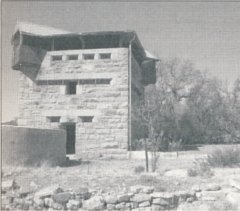

 The South African
The South African

Exterior view
Dear Editor
I beg to differ that the Stormberg blockhouse is the only one used as a dwelling (R Tomlinson, letter, MHJ Vol 14 No 2, December 2008, p69). There are at least two others to my knowledge. A hexagonal blockhouse is occupied by a family as part of a private residence in Aliwal North, while another is used for residential purposes by a family in Norvalspont.
Steve Watt, Pietermaritzburg
'Christian' or 'Christiaan'?
Dear Editor
Lest anyone doubt that J C Smuts's second name should be spelt with just a single 'a', I refer all to the biography of his father written by J C Smuts Jnr and particularly to p6, where it could not be clearer. However, it seems a hard nut to crack in South Africa.
Brian Austin
Spies and Nattrass (eds), Jan Smuts: Memoirs of the Boer War (Jonathan Ball, 1994), p11: 'According to Smuts's most authoritative biographer, W K Hancock (The Sanguine Years, p3) his name is spelt "Christiaan" in the Baptismal Register, but in the biography written by his son, his name is spelt "Christian".' Ed.
Owing to space constraints in the MHJ Vol 14 No 2, December 2008, a shortened version of Richard Tomlinson's letter regarding blockhouse accommodation was published. To avoid confusion, the letter is re-published here, in full, with photographs:

Below: Blockhouse first floor interior.
(Photos: By courtesy, Richard Tomlinson).
Dear Editor
This must surely be a first for South Africa - An Anglo-Boer War blockhouse converted into a self-catering overnight stay. This is the 'Standard Pattern' South Blockhouse at Stormberg Junction, which I first visited and recorded in 1996. At the time, I believed it to be the best preserved of any I had seen, and this still holds true. It is complete with its corrugated iron roof, steel machicouli galleries, floors, wooden staircases, even an extra door at ground level; all seemingly original, probably because it was within the periphery of a large British camp protecting this important railway junction. I believe it has survived in this state because it is off the 'vandal routes'.
The blockhouse, together with several adjacent outbuildings of a hotel (which has since been demolished), has been bought by a local farmer's wife who had to undertake minimal repair work and repainted the buildings to provide toilet and shower facilities, an extra bedroom and a restaurant which is used for large groups. The blockhouse sleeps three and all that was needed was a coat of paint on the walls of the ground and first floor rooms, dosing the loopholes with glass, shade netting around the open sides of the top floor and repairs to gutters and downpipes.
This facility is close to the Stormberg battlefied and war graves (10 December 1899) and formed part of the weekend tour of the Eastern Cape branch of SAMHS from 1 August to 2 September. Further details can be obtained from Marie Pretorius at Tel: 045 967 9452.
Richard Tomlinson, Port Elizabeth
ERRATA MHJ Volume 13 No 5, June 2006
David Panagos would like to draw the attention of readers to several editing errors which appear in his article, 'Fort Chameleon', published in Military History Journal (incorporating Museum Review), Volume 13 No 5, June 2006, pp184-7: Firstly, the statement, 'after striking the Union Jack, Lt Commeline and his garrison marched away, leaving Fort Commeline' (p185) gives readers the entirely wrong impression that Commeline surrendered, which he most certainly did not do. The correct term should have been left as 'taking down'. Secondly, the term 'covered way' (p185) was changed to a flaccid 'pathway' and should have been left as the original, which is a military term derived from the original term 'covert way' and dates to medieval star forts. The massive stone walls referred to here average 1,8m in height and 0,5m in thickness and lead down to the Sentraalmagasyn, as shown on Col Jackson's map (1900, Pretoria). Numerous other deletions and additions in the text, intended to prevent unnecessary repetition or to clarify a point made by the author, were considered by the author to have changed the original meaning, and this is regretted. The editor apologises for the errors and for any inconvenience they may have caused.
Return to Journal Index OR Society's Home page
South African Military History Society / scribe@samilitaryhistory.org